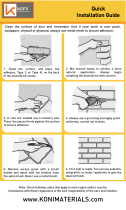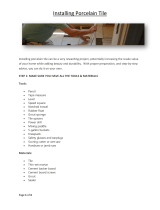
SCOPE
Interior installations of Giorbello rear-coated glass tiles on walls in dry areas.
WARRANTY
LATICRETE ‘Systems’ installations are covered by a comprehensive 5 year warranty (Reference LATICRETE DS 230.05 APD).
MATERIALS
Tiles: Giorbello rear-coated glass tiles as distributed by Giorbello Glass Tiles; http://www.giorbello.com
Latex Portland Cement Thick Bed Mortar: LATICRETE
®
3701 Fortified Mortar Bed
Crack Suppression Membrane: LATICRETE Hydro Ban
™
Latex Portland Cement Thinset Mortar: LATICRETE Glass Tile Adhesive Mortar
Latex Portland Cement Unsanded Grout: LATICRETE 1600 Unsanded Grout mixed with LATICRETE 1776 Grout Enhancer [For
joint widths less than or equal to 1/8 inch (3mm)]
100% Silicone Caulk: LATICRETE Latasil
™
Tile installation materials to be supplied by LATICRETE International, Inc.; Bethany, CT; USA Telephone: 1 (203) 393-0010; Fax: 1
(203) 393-1684; E-mail: technicalservi[email protected]; Website: www.laticrete.com.
PREPARATIONS
The contractor is to examine substrates and advise the General Contractor and Architect of existing conditions and surface
contamination requiring correction before work commences. Before starting, substrates are to comply with deflection requirements as
defined by International Building Code (IBC), International Residential Code (IRC), or applicable local building code. Substrates are to
be cleaned to remove curing compounds, sealers, soil, mortar, dirt, dust, etc. Curing compounds and sealers are to be mechanically
removed (e.g. metal bead-blasting, grit / sand blasting, diamond wheel grinding with vacuum attachment). After removal of the curing
compounds and sealers, all rough, uneven or "out-of-plumb" surfaces must be made "plumb and true" to within 1/8" in 10’ (3 mm in 3
m) and 1/16” in 1’ (1.5 mm 300 mm) using LATICRETE 3701 Fortified Mortar Bed. Dry, dusty concrete or masonry surfaces must be
water washed and excess water removed just prior to the application of LATICRETE installation materials.
EXPANSION AND CONTROL JOINTS
Existing joints in substrate must be carried through the tile work and conform to architectural details. Expansion joints to be installed
where tile work abuts restraining surfaces, such as perimeter walls, curbs, columns, corners, etc. Expansion joints to be installed at all
"changes of plane" in tile work. Refer to Tile Council of North America (TCNA) Detail EJ-171 (Current Year) for industry
recommendations.
INSTALLATION OF CRACK SUPPRESSION MEMBRANE
Install LATICRETE Hydro Ban over all hairline cracks (≤ 1/8” or 3mm) in surfaces, prior to installing tiles, in accordance with the
LATICRETE
®
written installation instructions. Refer to LATICRETE DS 663.0 and DS 663.5 for complete information.
MIXING
Mix according to LATICRETE printed product instructions included with each product package.
Giorbello Glass Tiles
Installation Guidelines
Giorbello

THINSET INSTALLATION OF TILES
Ensure that the backs of the glass tiles have been thoroughly washed, rinsed, and completely dried prior to installation. Use
LATICRETE Glass Tile Adhesive Mortar to install tiles, via thin-set method. Installation is to comply with current revisions of ANSI
A108.02 (3.11), A108.1B and ANSI A108.5. Use an appropriate sized notched trowel to that facilitate full coverage of the thinset
mortar to the backs of the tiles. Use the flat side of the trowel to firmly apply LATICRETE Glass Tile Adhesive Mortar onto the
substrate. Next, apply LATICRETE Glass Tile Adhesive Mortar in a horizontal direction using notched side of the trowel. Use the flat
side of the trowel to knock down the ridges and create a smooth setting bed. Check for voids and fill in where necessary. Next, back
butter each clean, dry tile using LATICRETE Glass Tile Adhesive Mortar. Verify that 100% coverage has been achieved by removing a
tile while the thin-set mortar is still fresh. The face of the glass tile can also be checked before setting to verify the appearance of full
coverage. Tiles must be dry prior to installation to avoid the appearance of water spots on backs of tile. Apply glass tile into the wet
thin-set mortar using firm, even pressure to establish contact and eliminate any voids. Remove excess thin-set mortar from in between
tile edges. If voids or water spots in the thin-set mortar are visible through the tiles, remove the tile and correct the installation at this
point. Allow t tile installation to cure a minimum of 48 hours at 70°F (21°C) prior to grouting. Clean excess thin-set mortar from the face
of the glass tiles and joints between pieces while fresh, before it hardens.
GROUTING
Allow tile installation to cure for minimum of 48 hours @ 70° F (21°C). Verify grout joints are free of dirt, debris and tile spacers.
Sponge wipe dust/dirt off tile faces and remove any water standing in joints. Surface temperature must be between 40-90° F (4-32°C).
Mixing: Use approximately 4.5–5 qts (4.2–4.7 l) of clean potable water or 4.4 qts (4.18 l) of LATICRETE 1776 Grout Enhancer for 25
lbs. (11.3 kg) or 1.4–1.6 qts (1.3–1.5 l) of clean potable water or 1.5 quarts (1.4 l) of LATICRETE 1776 Grout Enhancer to 8 lbs. (3.6
kg) of LATICRETE 1600 Unsanded Grout powder. Place water in a clean mixing container and add grout powder slowly. Mix by hand
or with a slow speed mixer to a smooth, stiff consistency. Allow to slake for 5–10 minutes and remix. Install latex Portland cement grout
in compliance with current revisions of ANSI A108.1A (7.0 Grouting of tile), ANSI A108.02 (4.5 Cleaning tile) and ANSI A108.10.
Dampen dry surfaces with clean water. Spread using a sharp edged, hard rubber float and work grout into joints. Using diagonal (at
45° angle to direction of grout line) strokes, pack joints full and free of voids/pits. Hold float face at a 90° angle to tile surface and use
float edge to "squeegee" off excess grout, stroking diagonally to reduce pulling grout out of filled joints. Initial cleaning can begin as
soon as grout has become firm, typically 15-20 minutes after grouting @ 70° F (21°C). Higher temperatures may require faster time to
initial cleaning; wider joints or lower temperatures may require a longer time to initial cleaning. Begin initial cleaning by lightly
dampening the entire grouted area with a damp sponge. Then wash clean the entire area with a damp (not wet) sponge. Drag a clean
damp sponge diagonally over the tile surface to remove all grout haze left after “squeegeeing.” Rinse sponge frequently. Change rinse
water at least every 200 ft
2
(19m
2
). Repeat this cleaning sequence again if grout haze is still present. Allow grout joints to become firm.
Buff surface of grout with clean fine cloth. Inspect joints for pinholes/voids and repair them with freshly mixed grout. Within 24 hours,
check for remaining haze and remove it with warm soapy water and a nylon scrubbing pad, using a circular motion, to lightly scrub
surfaces and dissolve haze/film. Do not use acid cleaners on glass tile installations.
PROTECTION
The contractor must take precautions to protect the finished work from damage by other trades. Allow the cement grout to cure for a
minimum of 7 days at 70° F (21° C) before aggressive cleaning.
COLD WEATHER NOTE
The curing of installation materials is retarded by low temperatures and finished work should be protected for an extended period of
time. Typically, for every 18º F below 70º F (10ºC below 21ºC), installation materials take twice as long to cure.
LATICRETE Technical Services provides review of job specifications and plans, project detail planning and review, and provides answers to questions concerning the installation of
ceramic tile, brick, marble and stone. Call toll free USA +1 (203) 393-0010. Fax: USA +1 (203) 393-1684. E-mail: technicalserv[email protected], Internet: www.laticrete.com. To obtain
a copy of detailed product information, most recent revisions of LATICRETE data sheets, and answers to installation questions, E-mail: technicalservices@laticrete.com or call (800) 243-
4788 x.235.
© 2011 LATICRETE INTERNATIONAL, Inc. The rights to copy, distribute, and utilize for commercial purposes is specifically granted to Stone and Tile Importers and manufacturers,
Architects, Engineers, and Specifications Writers.
R 13 January 2011
-
 1
1
-
 2
2
Ask a question and I''ll find the answer in the document
Finding information in a document is now easier with AI
Related papers
Other documents
-
 Koni Brick KBFT-252RSE Installation guide
Koni Brick KBFT-252RSE Installation guide
-
daltile 9999575239 User manual
-
Mirrella 45060 Installation guide
-
Ivy Hill Tile SMP-REFTRPGRY User manual
-
Jeffrey Court 94004 Installation guide
-
Unbranded BAFL0624241P Installation guide
-
Jeffrey Court 13067 Installation guide
-
daltile 9999575238 Installation guide
-
Unbranded NDUTASH7X20-SAM Installation guide
-
 TRUE PORCELAIN CO. 1100739 Installation guide
TRUE PORCELAIN CO. 1100739 Installation guide




